Bachelors of Humanitarian Work: Communication Skills & Helping Process
VerifiedAdded on 2023/06/04
|6
|2166
|432
Essay
AI Summary
This essay provides a comprehensive overview of the helping process, emphasizing the crucial role of communication skills at each stage. It begins by outlining the stages of the helping process, including relationship building, assessment, goal setting, intervention, and termination. The essay then integrates key communication skills such as attending, active listening, questioning, and empathy, highlighting their importance in facilitating effective interaction and understanding between the helper and the client. Furthermore, it identifies potential barriers to communication, such as emotional, perceptual, and language barriers, as well as distractions and the use of technical language. Finally, the essay discusses strategies to address these barriers, including tailoring communication to the client's needs, using clear and simple language, focusing on the issue rather than the person, and creating a conducive environment for open communication. The essay concludes by emphasizing the importance of open communication in ensuring client satisfaction and effective problem-solving.
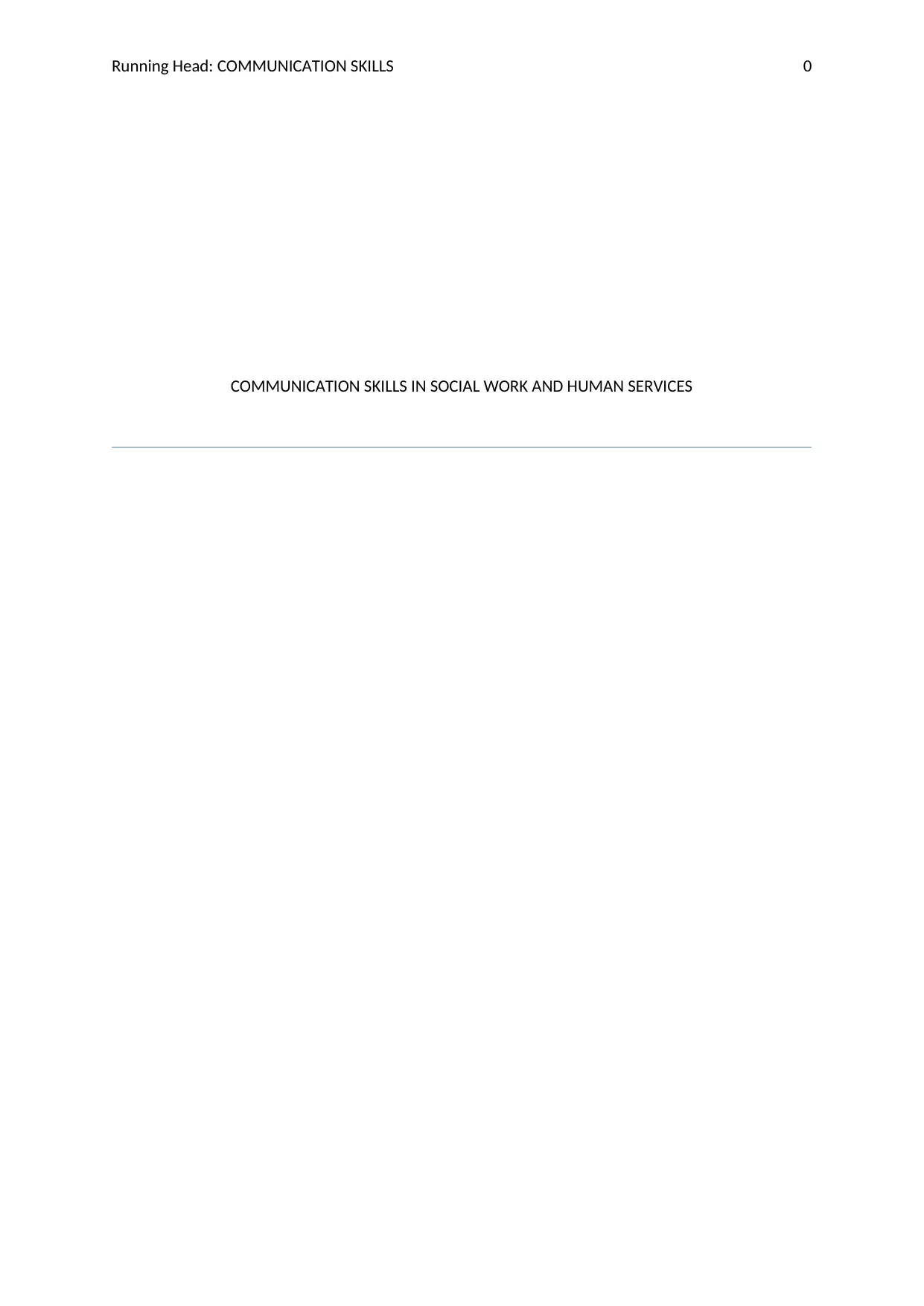
Running Head: COMMUNICATION SKILLS 0
COMMUNICATION SKILLS IN SOCIAL WORK AND HUMAN SERVICES
COMMUNICATION SKILLS IN SOCIAL WORK AND HUMAN SERVICES
Paraphrase This Document
Need a fresh take? Get an instant paraphrase of this document with our AI Paraphraser
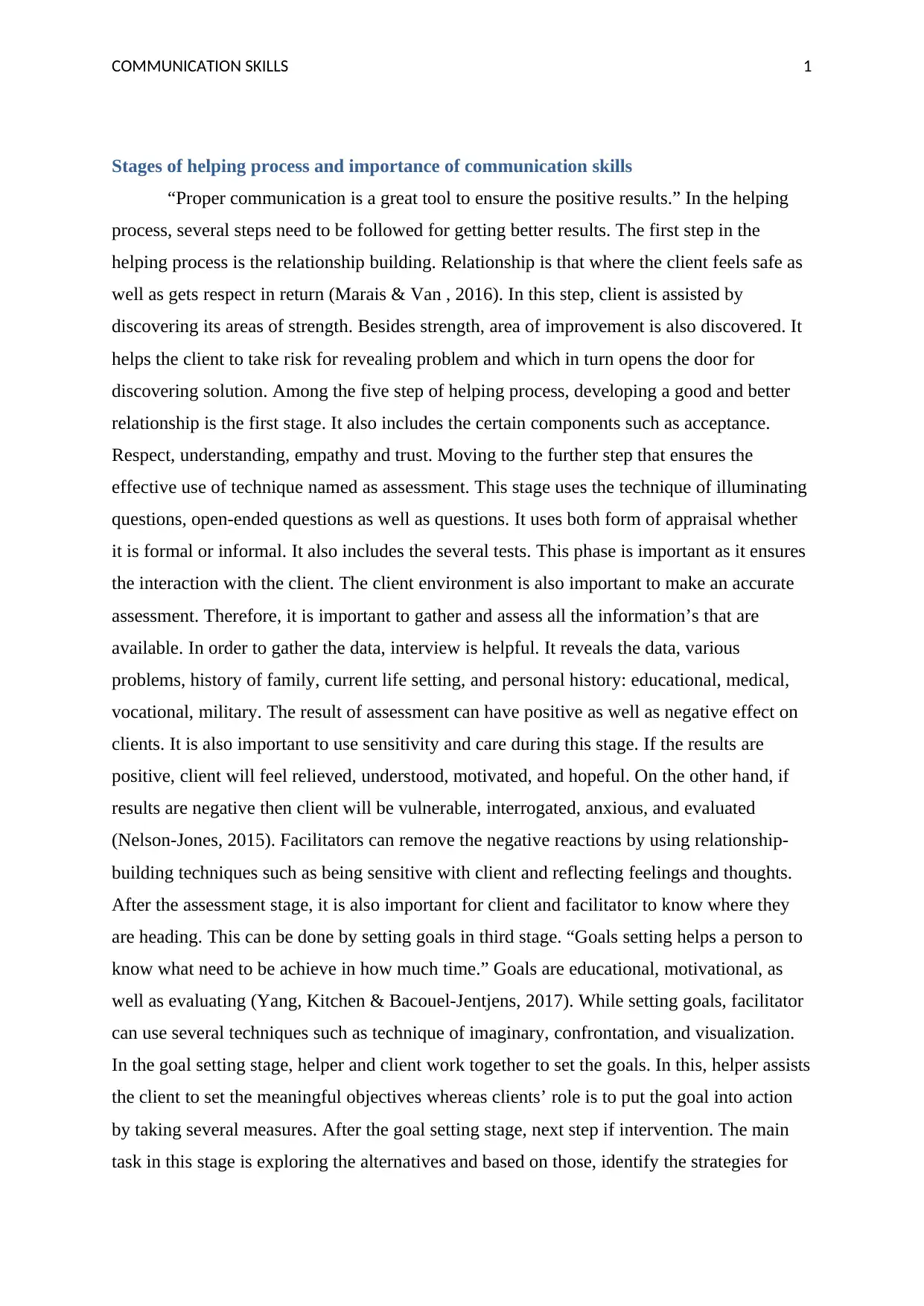
COMMUNICATION SKILLS 1
Stages of helping process and importance of communication skills
“Proper communication is a great tool to ensure the positive results.” In the helping
process, several steps need to be followed for getting better results. The first step in the
helping process is the relationship building. Relationship is that where the client feels safe as
well as gets respect in return (Marais & Van , 2016). In this step, client is assisted by
discovering its areas of strength. Besides strength, area of improvement is also discovered. It
helps the client to take risk for revealing problem and which in turn opens the door for
discovering solution. Among the five step of helping process, developing a good and better
relationship is the first stage. It also includes the certain components such as acceptance.
Respect, understanding, empathy and trust. Moving to the further step that ensures the
effective use of technique named as assessment. This stage uses the technique of illuminating
questions, open-ended questions as well as questions. It uses both form of appraisal whether
it is formal or informal. It also includes the several tests. This phase is important as it ensures
the interaction with the client. The client environment is also important to make an accurate
assessment. Therefore, it is important to gather and assess all the information’s that are
available. In order to gather the data, interview is helpful. It reveals the data, various
problems, history of family, current life setting, and personal history: educational, medical,
vocational, military. The result of assessment can have positive as well as negative effect on
clients. It is also important to use sensitivity and care during this stage. If the results are
positive, client will feel relieved, understood, motivated, and hopeful. On the other hand, if
results are negative then client will be vulnerable, interrogated, anxious, and evaluated
(Nelson-Jones, 2015). Facilitators can remove the negative reactions by using relationship-
building techniques such as being sensitive with client and reflecting feelings and thoughts.
After the assessment stage, it is also important for client and facilitator to know where they
are heading. This can be done by setting goals in third stage. “Goals setting helps a person to
know what need to be achieve in how much time.” Goals are educational, motivational, as
well as evaluating (Yang, Kitchen & Bacouel-Jentjens, 2017). While setting goals, facilitator
can use several techniques such as technique of imaginary, confrontation, and visualization.
In the goal setting stage, helper and client work together to set the goals. In this, helper assists
the client to set the meaningful objectives whereas clients’ role is to put the goal into action
by taking several measures. After the goal setting stage, next step if intervention. The main
task in this stage is exploring the alternatives and based on those, identify the strategies for
Stages of helping process and importance of communication skills
“Proper communication is a great tool to ensure the positive results.” In the helping
process, several steps need to be followed for getting better results. The first step in the
helping process is the relationship building. Relationship is that where the client feels safe as
well as gets respect in return (Marais & Van , 2016). In this step, client is assisted by
discovering its areas of strength. Besides strength, area of improvement is also discovered. It
helps the client to take risk for revealing problem and which in turn opens the door for
discovering solution. Among the five step of helping process, developing a good and better
relationship is the first stage. It also includes the certain components such as acceptance.
Respect, understanding, empathy and trust. Moving to the further step that ensures the
effective use of technique named as assessment. This stage uses the technique of illuminating
questions, open-ended questions as well as questions. It uses both form of appraisal whether
it is formal or informal. It also includes the several tests. This phase is important as it ensures
the interaction with the client. The client environment is also important to make an accurate
assessment. Therefore, it is important to gather and assess all the information’s that are
available. In order to gather the data, interview is helpful. It reveals the data, various
problems, history of family, current life setting, and personal history: educational, medical,
vocational, military. The result of assessment can have positive as well as negative effect on
clients. It is also important to use sensitivity and care during this stage. If the results are
positive, client will feel relieved, understood, motivated, and hopeful. On the other hand, if
results are negative then client will be vulnerable, interrogated, anxious, and evaluated
(Nelson-Jones, 2015). Facilitators can remove the negative reactions by using relationship-
building techniques such as being sensitive with client and reflecting feelings and thoughts.
After the assessment stage, it is also important for client and facilitator to know where they
are heading. This can be done by setting goals in third stage. “Goals setting helps a person to
know what need to be achieve in how much time.” Goals are educational, motivational, as
well as evaluating (Yang, Kitchen & Bacouel-Jentjens, 2017). While setting goals, facilitator
can use several techniques such as technique of imaginary, confrontation, and visualization.
In the goal setting stage, helper and client work together to set the goals. In this, helper assists
the client to set the meaningful objectives whereas clients’ role is to put the goal into action
by taking several measures. After the goal setting stage, next step if intervention. The main
task in this stage is exploring the alternatives and based on those, identify the strategies for
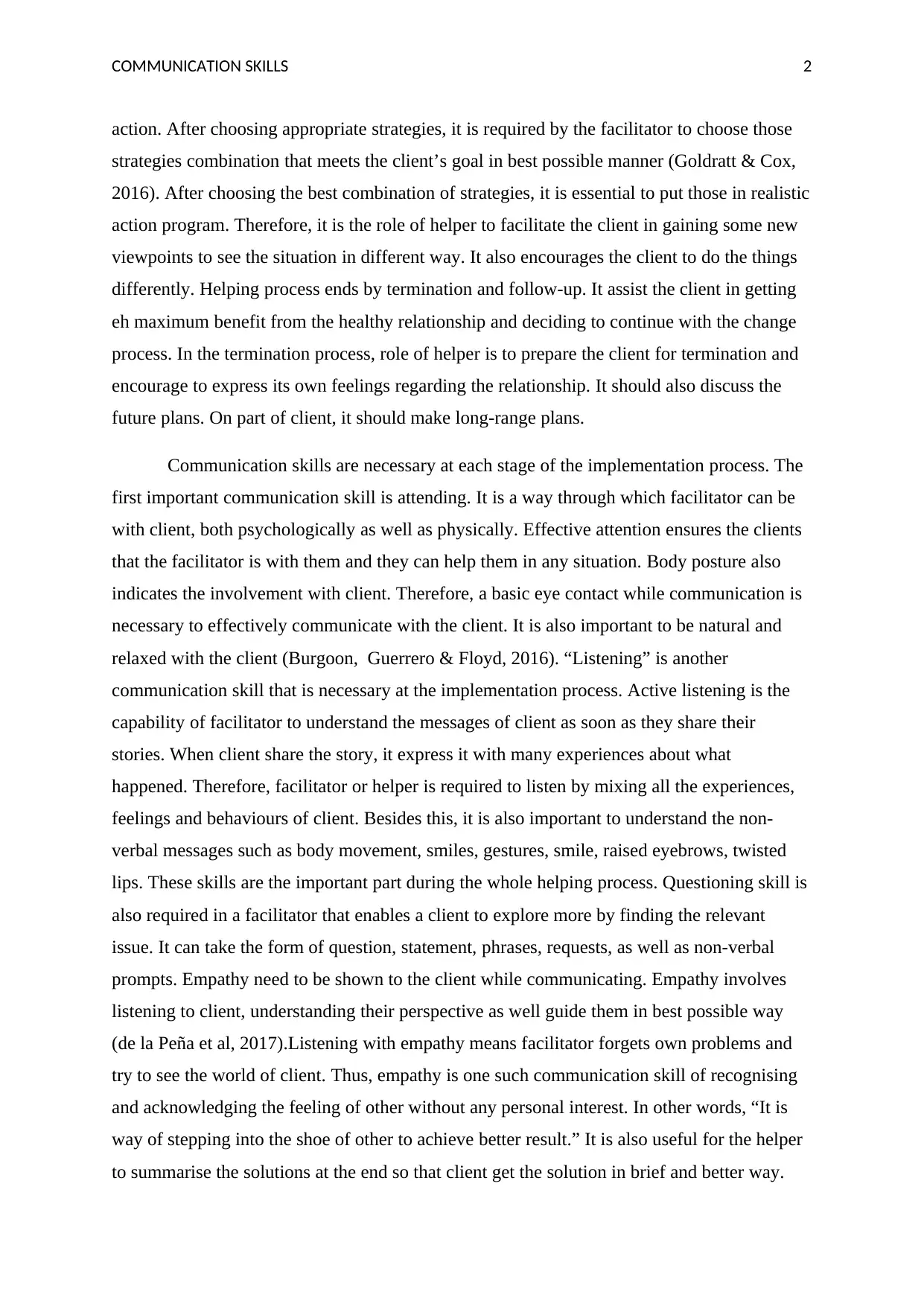
COMMUNICATION SKILLS 2
action. After choosing appropriate strategies, it is required by the facilitator to choose those
strategies combination that meets the client’s goal in best possible manner (Goldratt & Cox,
2016). After choosing the best combination of strategies, it is essential to put those in realistic
action program. Therefore, it is the role of helper to facilitate the client in gaining some new
viewpoints to see the situation in different way. It also encourages the client to do the things
differently. Helping process ends by termination and follow-up. It assist the client in getting
eh maximum benefit from the healthy relationship and deciding to continue with the change
process. In the termination process, role of helper is to prepare the client for termination and
encourage to express its own feelings regarding the relationship. It should also discuss the
future plans. On part of client, it should make long-range plans.
Communication skills are necessary at each stage of the implementation process. The
first important communication skill is attending. It is a way through which facilitator can be
with client, both psychologically as well as physically. Effective attention ensures the clients
that the facilitator is with them and they can help them in any situation. Body posture also
indicates the involvement with client. Therefore, a basic eye contact while communication is
necessary to effectively communicate with the client. It is also important to be natural and
relaxed with the client (Burgoon, Guerrero & Floyd, 2016). “Listening” is another
communication skill that is necessary at the implementation process. Active listening is the
capability of facilitator to understand the messages of client as soon as they share their
stories. When client share the story, it express it with many experiences about what
happened. Therefore, facilitator or helper is required to listen by mixing all the experiences,
feelings and behaviours of client. Besides this, it is also important to understand the non-
verbal messages such as body movement, smiles, gestures, smile, raised eyebrows, twisted
lips. These skills are the important part during the whole helping process. Questioning skill is
also required in a facilitator that enables a client to explore more by finding the relevant
issue. It can take the form of question, statement, phrases, requests, as well as non-verbal
prompts. Empathy need to be shown to the client while communicating. Empathy involves
listening to client, understanding their perspective as well guide them in best possible way
(de la Peña et al, 2017).Listening with empathy means facilitator forgets own problems and
try to see the world of client. Thus, empathy is one such communication skill of recognising
and acknowledging the feeling of other without any personal interest. In other words, “It is
way of stepping into the shoe of other to achieve better result.” It is also useful for the helper
to summarise the solutions at the end so that client get the solution in brief and better way.
action. After choosing appropriate strategies, it is required by the facilitator to choose those
strategies combination that meets the client’s goal in best possible manner (Goldratt & Cox,
2016). After choosing the best combination of strategies, it is essential to put those in realistic
action program. Therefore, it is the role of helper to facilitate the client in gaining some new
viewpoints to see the situation in different way. It also encourages the client to do the things
differently. Helping process ends by termination and follow-up. It assist the client in getting
eh maximum benefit from the healthy relationship and deciding to continue with the change
process. In the termination process, role of helper is to prepare the client for termination and
encourage to express its own feelings regarding the relationship. It should also discuss the
future plans. On part of client, it should make long-range plans.
Communication skills are necessary at each stage of the implementation process. The
first important communication skill is attending. It is a way through which facilitator can be
with client, both psychologically as well as physically. Effective attention ensures the clients
that the facilitator is with them and they can help them in any situation. Body posture also
indicates the involvement with client. Therefore, a basic eye contact while communication is
necessary to effectively communicate with the client. It is also important to be natural and
relaxed with the client (Burgoon, Guerrero & Floyd, 2016). “Listening” is another
communication skill that is necessary at the implementation process. Active listening is the
capability of facilitator to understand the messages of client as soon as they share their
stories. When client share the story, it express it with many experiences about what
happened. Therefore, facilitator or helper is required to listen by mixing all the experiences,
feelings and behaviours of client. Besides this, it is also important to understand the non-
verbal messages such as body movement, smiles, gestures, smile, raised eyebrows, twisted
lips. These skills are the important part during the whole helping process. Questioning skill is
also required in a facilitator that enables a client to explore more by finding the relevant
issue. It can take the form of question, statement, phrases, requests, as well as non-verbal
prompts. Empathy need to be shown to the client while communicating. Empathy involves
listening to client, understanding their perspective as well guide them in best possible way
(de la Peña et al, 2017).Listening with empathy means facilitator forgets own problems and
try to see the world of client. Thus, empathy is one such communication skill of recognising
and acknowledging the feeling of other without any personal interest. In other words, “It is
way of stepping into the shoe of other to achieve better result.” It is also useful for the helper
to summarise the solutions at the end so that client get the solution in brief and better way.
⊘ This is a preview!⊘
Do you want full access?
Subscribe today to unlock all pages.

Trusted by 1+ million students worldwide
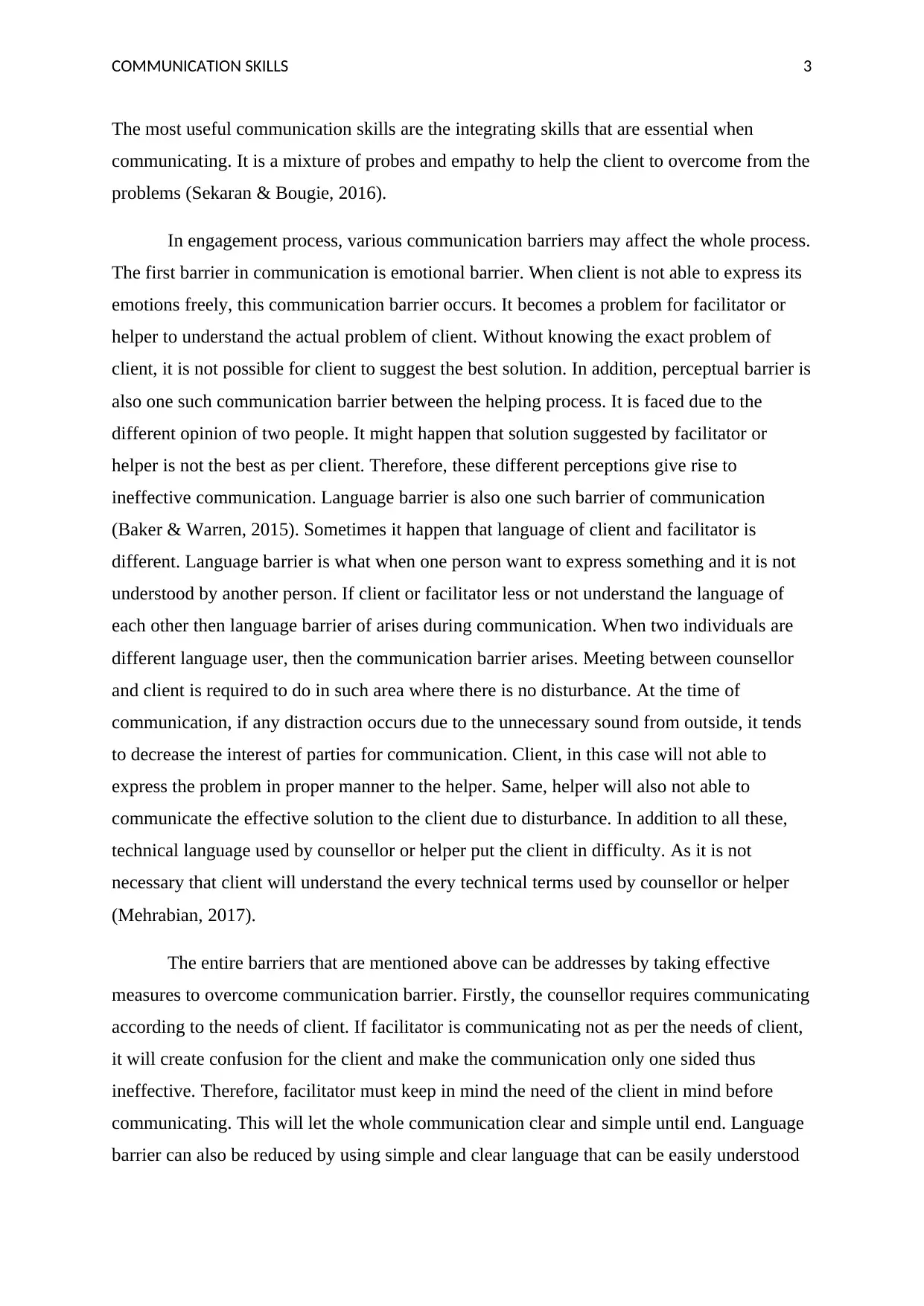
COMMUNICATION SKILLS 3
The most useful communication skills are the integrating skills that are essential when
communicating. It is a mixture of probes and empathy to help the client to overcome from the
problems (Sekaran & Bougie, 2016).
In engagement process, various communication barriers may affect the whole process.
The first barrier in communication is emotional barrier. When client is not able to express its
emotions freely, this communication barrier occurs. It becomes a problem for facilitator or
helper to understand the actual problem of client. Without knowing the exact problem of
client, it is not possible for client to suggest the best solution. In addition, perceptual barrier is
also one such communication barrier between the helping process. It is faced due to the
different opinion of two people. It might happen that solution suggested by facilitator or
helper is not the best as per client. Therefore, these different perceptions give rise to
ineffective communication. Language barrier is also one such barrier of communication
(Baker & Warren, 2015). Sometimes it happen that language of client and facilitator is
different. Language barrier is what when one person want to express something and it is not
understood by another person. If client or facilitator less or not understand the language of
each other then language barrier of arises during communication. When two individuals are
different language user, then the communication barrier arises. Meeting between counsellor
and client is required to do in such area where there is no disturbance. At the time of
communication, if any distraction occurs due to the unnecessary sound from outside, it tends
to decrease the interest of parties for communication. Client, in this case will not able to
express the problem in proper manner to the helper. Same, helper will also not able to
communicate the effective solution to the client due to disturbance. In addition to all these,
technical language used by counsellor or helper put the client in difficulty. As it is not
necessary that client will understand the every technical terms used by counsellor or helper
(Mehrabian, 2017).
The entire barriers that are mentioned above can be addresses by taking effective
measures to overcome communication barrier. Firstly, the counsellor requires communicating
according to the needs of client. If facilitator is communicating not as per the needs of client,
it will create confusion for the client and make the communication only one sided thus
ineffective. Therefore, facilitator must keep in mind the need of the client in mind before
communicating. This will let the whole communication clear and simple until end. Language
barrier can also be reduced by using simple and clear language that can be easily understood
The most useful communication skills are the integrating skills that are essential when
communicating. It is a mixture of probes and empathy to help the client to overcome from the
problems (Sekaran & Bougie, 2016).
In engagement process, various communication barriers may affect the whole process.
The first barrier in communication is emotional barrier. When client is not able to express its
emotions freely, this communication barrier occurs. It becomes a problem for facilitator or
helper to understand the actual problem of client. Without knowing the exact problem of
client, it is not possible for client to suggest the best solution. In addition, perceptual barrier is
also one such communication barrier between the helping process. It is faced due to the
different opinion of two people. It might happen that solution suggested by facilitator or
helper is not the best as per client. Therefore, these different perceptions give rise to
ineffective communication. Language barrier is also one such barrier of communication
(Baker & Warren, 2015). Sometimes it happen that language of client and facilitator is
different. Language barrier is what when one person want to express something and it is not
understood by another person. If client or facilitator less or not understand the language of
each other then language barrier of arises during communication. When two individuals are
different language user, then the communication barrier arises. Meeting between counsellor
and client is required to do in such area where there is no disturbance. At the time of
communication, if any distraction occurs due to the unnecessary sound from outside, it tends
to decrease the interest of parties for communication. Client, in this case will not able to
express the problem in proper manner to the helper. Same, helper will also not able to
communicate the effective solution to the client due to disturbance. In addition to all these,
technical language used by counsellor or helper put the client in difficulty. As it is not
necessary that client will understand the every technical terms used by counsellor or helper
(Mehrabian, 2017).
The entire barriers that are mentioned above can be addresses by taking effective
measures to overcome communication barrier. Firstly, the counsellor requires communicating
according to the needs of client. If facilitator is communicating not as per the needs of client,
it will create confusion for the client and make the communication only one sided thus
ineffective. Therefore, facilitator must keep in mind the need of the client in mind before
communicating. This will let the whole communication clear and simple until end. Language
barrier can also be reduced by using simple and clear language that can be easily understood
Paraphrase This Document
Need a fresh take? Get an instant paraphrase of this document with our AI Paraphraser
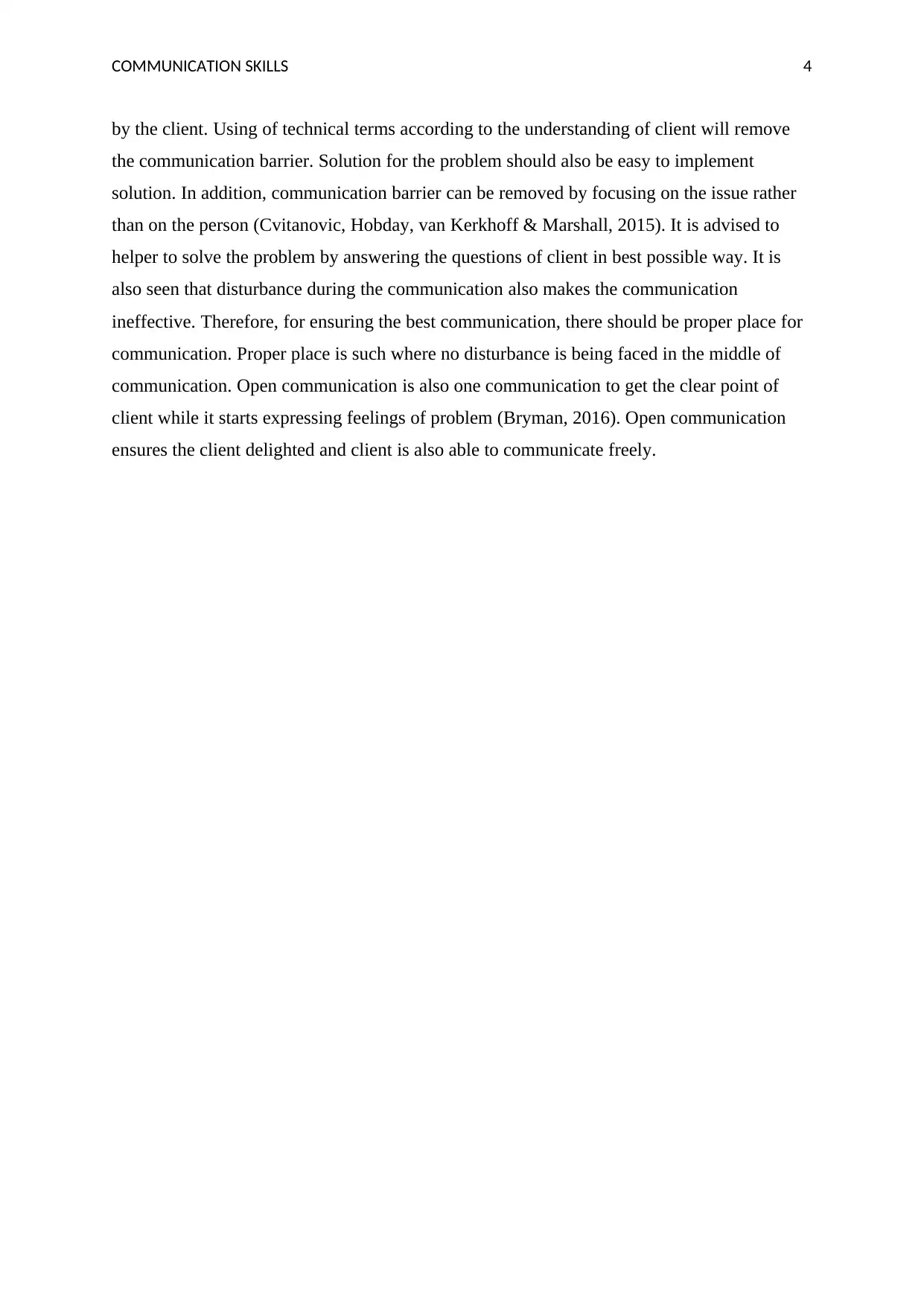
COMMUNICATION SKILLS 4
by the client. Using of technical terms according to the understanding of client will remove
the communication barrier. Solution for the problem should also be easy to implement
solution. In addition, communication barrier can be removed by focusing on the issue rather
than on the person (Cvitanovic, Hobday, van Kerkhoff & Marshall, 2015). It is advised to
helper to solve the problem by answering the questions of client in best possible way. It is
also seen that disturbance during the communication also makes the communication
ineffective. Therefore, for ensuring the best communication, there should be proper place for
communication. Proper place is such where no disturbance is being faced in the middle of
communication. Open communication is also one communication to get the clear point of
client while it starts expressing feelings of problem (Bryman, 2016). Open communication
ensures the client delighted and client is also able to communicate freely.
by the client. Using of technical terms according to the understanding of client will remove
the communication barrier. Solution for the problem should also be easy to implement
solution. In addition, communication barrier can be removed by focusing on the issue rather
than on the person (Cvitanovic, Hobday, van Kerkhoff & Marshall, 2015). It is advised to
helper to solve the problem by answering the questions of client in best possible way. It is
also seen that disturbance during the communication also makes the communication
ineffective. Therefore, for ensuring the best communication, there should be proper place for
communication. Proper place is such where no disturbance is being faced in the middle of
communication. Open communication is also one communication to get the clear point of
client while it starts expressing feelings of problem (Bryman, 2016). Open communication
ensures the client delighted and client is also able to communicate freely.
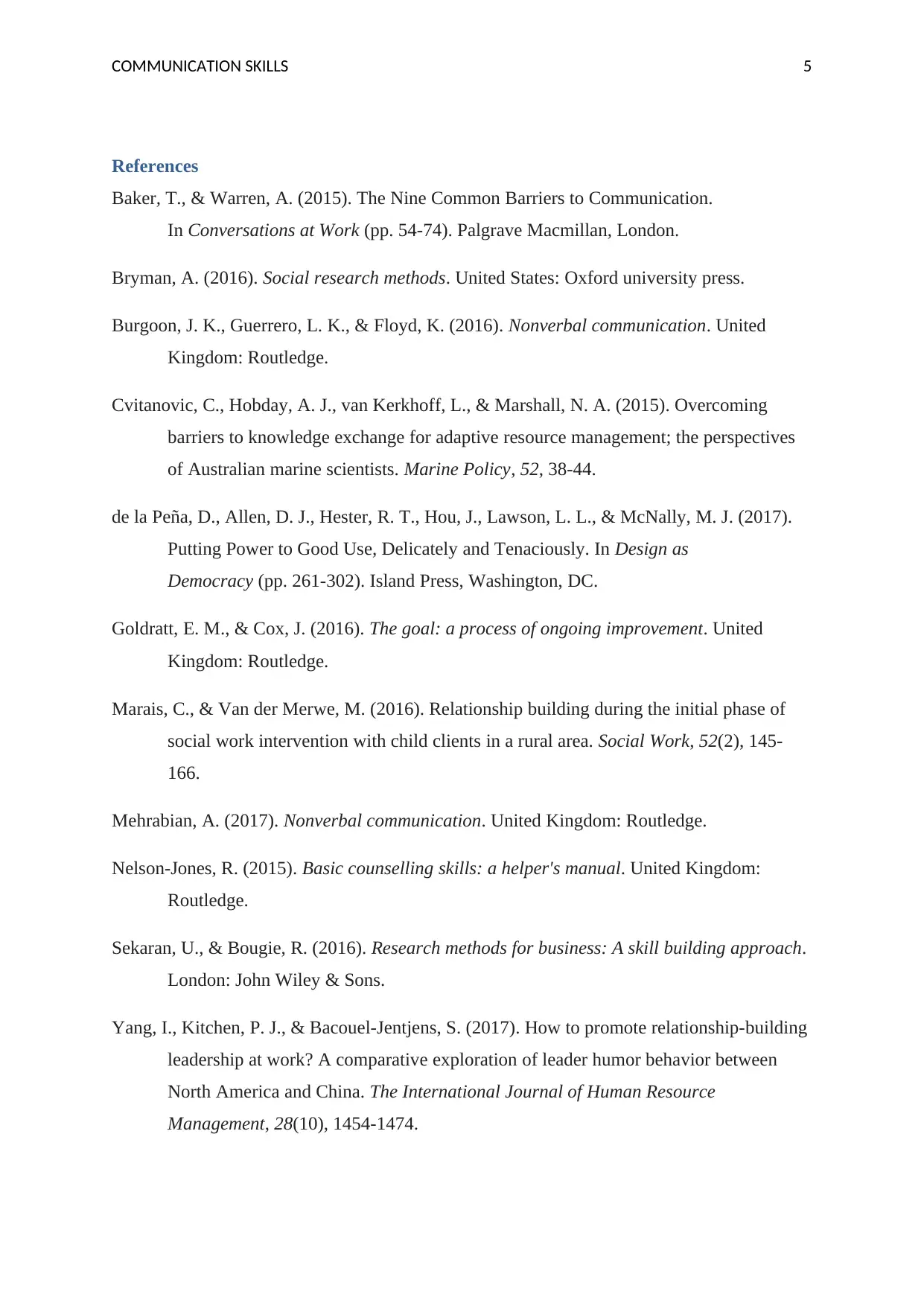
COMMUNICATION SKILLS 5
References
Baker, T., & Warren, A. (2015). The Nine Common Barriers to Communication.
In Conversations at Work (pp. 54-74). Palgrave Macmillan, London.
Bryman, A. (2016). Social research methods. United States: Oxford university press.
Burgoon, J. K., Guerrero, L. K., & Floyd, K. (2016). Nonverbal communication. United
Kingdom: Routledge.
Cvitanovic, C., Hobday, A. J., van Kerkhoff, L., & Marshall, N. A. (2015). Overcoming
barriers to knowledge exchange for adaptive resource management; the perspectives
of Australian marine scientists. Marine Policy, 52, 38-44.
de la Peña, D., Allen, D. J., Hester, R. T., Hou, J., Lawson, L. L., & McNally, M. J. (2017).
Putting Power to Good Use, Delicately and Tenaciously. In Design as
Democracy (pp. 261-302). Island Press, Washington, DC.
Goldratt, E. M., & Cox, J. (2016). The goal: a process of ongoing improvement. United
Kingdom: Routledge.
Marais, C., & Van der Merwe, M. (2016). Relationship building during the initial phase of
social work intervention with child clients in a rural area. Social Work, 52(2), 145-
166.
Mehrabian, A. (2017). Nonverbal communication. United Kingdom: Routledge.
Nelson-Jones, R. (2015). Basic counselling skills: a helper's manual. United Kingdom:
Routledge.
Sekaran, U., & Bougie, R. (2016). Research methods for business: A skill building approach.
London: John Wiley & Sons.
Yang, I., Kitchen, P. J., & Bacouel-Jentjens, S. (2017). How to promote relationship-building
leadership at work? A comparative exploration of leader humor behavior between
North America and China. The International Journal of Human Resource
Management, 28(10), 1454-1474.
References
Baker, T., & Warren, A. (2015). The Nine Common Barriers to Communication.
In Conversations at Work (pp. 54-74). Palgrave Macmillan, London.
Bryman, A. (2016). Social research methods. United States: Oxford university press.
Burgoon, J. K., Guerrero, L. K., & Floyd, K. (2016). Nonverbal communication. United
Kingdom: Routledge.
Cvitanovic, C., Hobday, A. J., van Kerkhoff, L., & Marshall, N. A. (2015). Overcoming
barriers to knowledge exchange for adaptive resource management; the perspectives
of Australian marine scientists. Marine Policy, 52, 38-44.
de la Peña, D., Allen, D. J., Hester, R. T., Hou, J., Lawson, L. L., & McNally, M. J. (2017).
Putting Power to Good Use, Delicately and Tenaciously. In Design as
Democracy (pp. 261-302). Island Press, Washington, DC.
Goldratt, E. M., & Cox, J. (2016). The goal: a process of ongoing improvement. United
Kingdom: Routledge.
Marais, C., & Van der Merwe, M. (2016). Relationship building during the initial phase of
social work intervention with child clients in a rural area. Social Work, 52(2), 145-
166.
Mehrabian, A. (2017). Nonverbal communication. United Kingdom: Routledge.
Nelson-Jones, R. (2015). Basic counselling skills: a helper's manual. United Kingdom:
Routledge.
Sekaran, U., & Bougie, R. (2016). Research methods for business: A skill building approach.
London: John Wiley & Sons.
Yang, I., Kitchen, P. J., & Bacouel-Jentjens, S. (2017). How to promote relationship-building
leadership at work? A comparative exploration of leader humor behavior between
North America and China. The International Journal of Human Resource
Management, 28(10), 1454-1474.
⊘ This is a preview!⊘
Do you want full access?
Subscribe today to unlock all pages.

Trusted by 1+ million students worldwide
1 out of 6
Related Documents
Your All-in-One AI-Powered Toolkit for Academic Success.
+13062052269
info@desklib.com
Available 24*7 on WhatsApp / Email
![[object Object]](/_next/static/media/star-bottom.7253800d.svg)
Unlock your academic potential
Copyright © 2020–2025 A2Z Services. All Rights Reserved. Developed and managed by ZUCOL.





